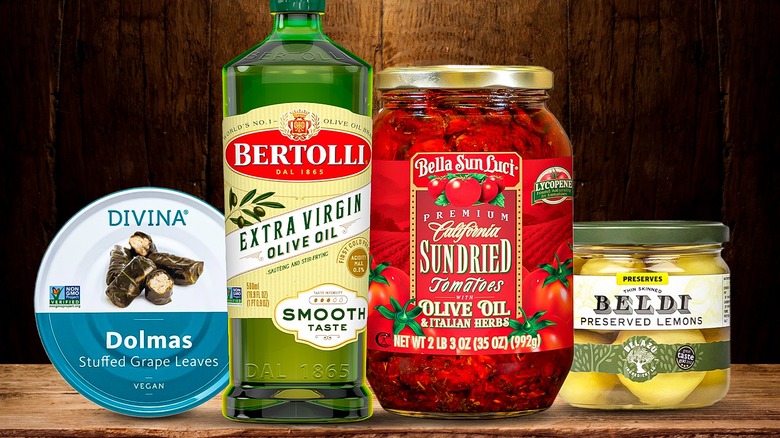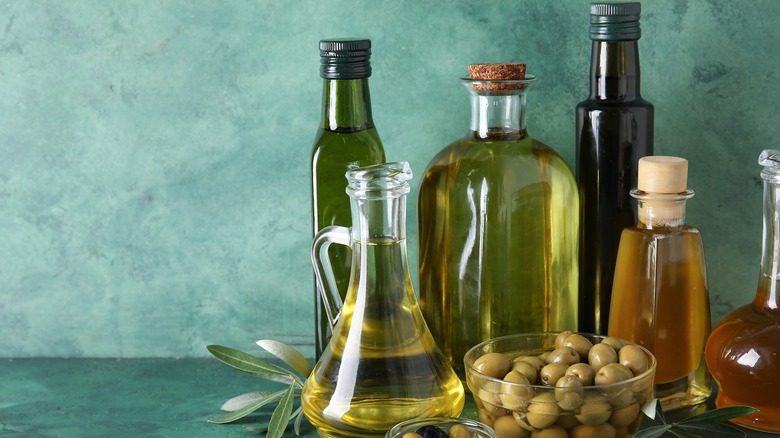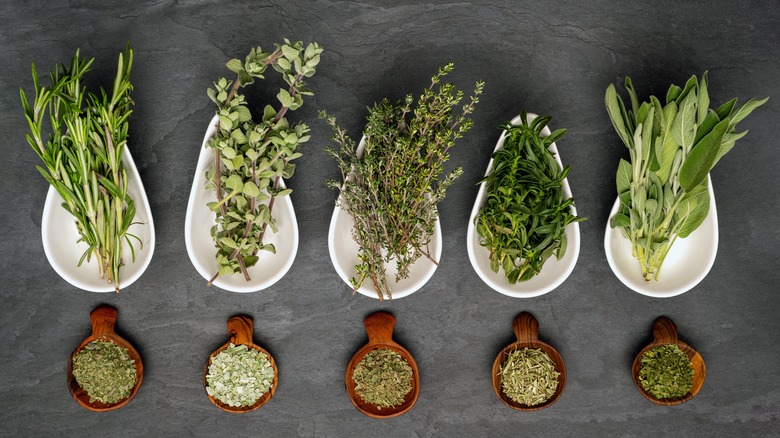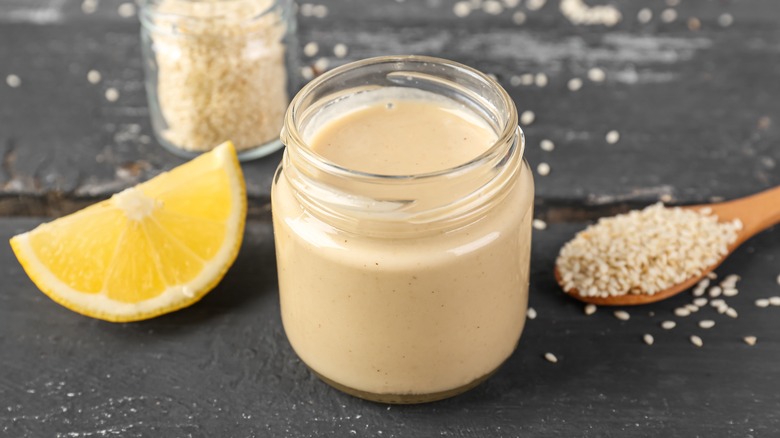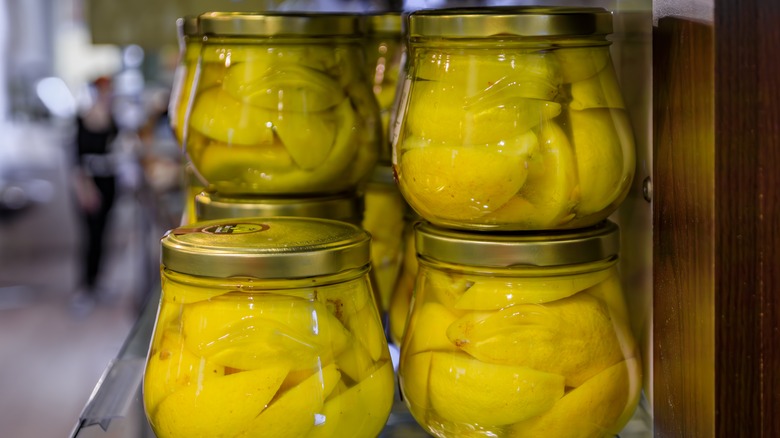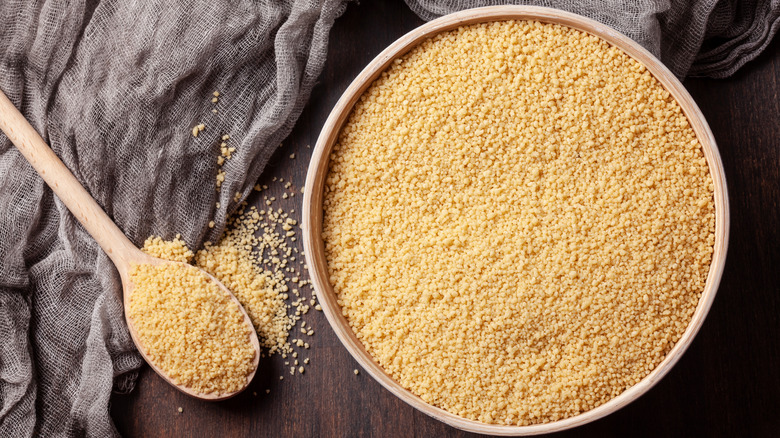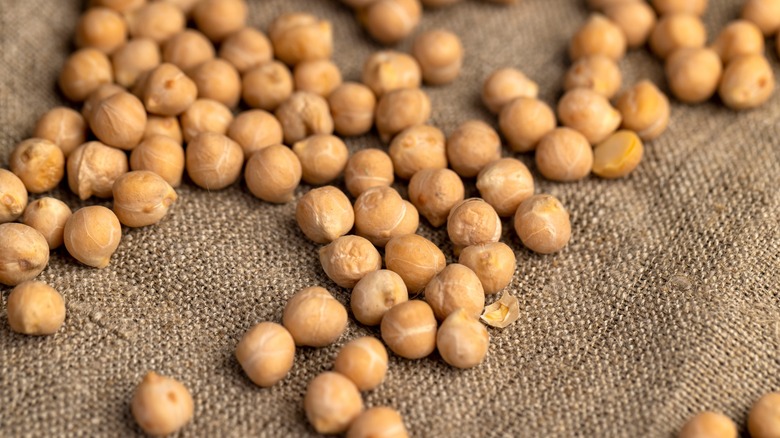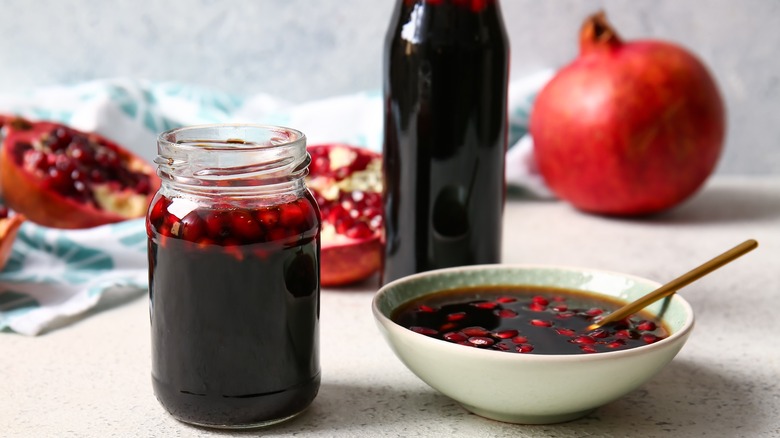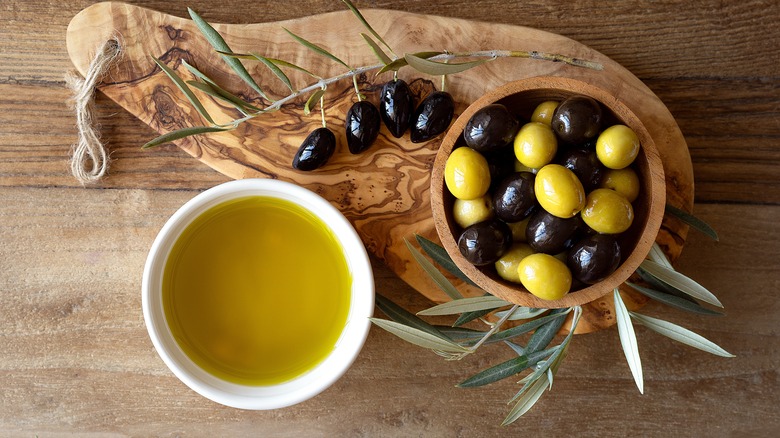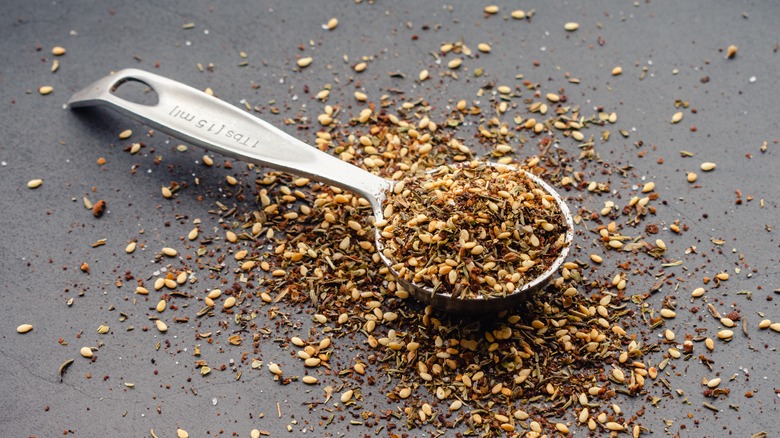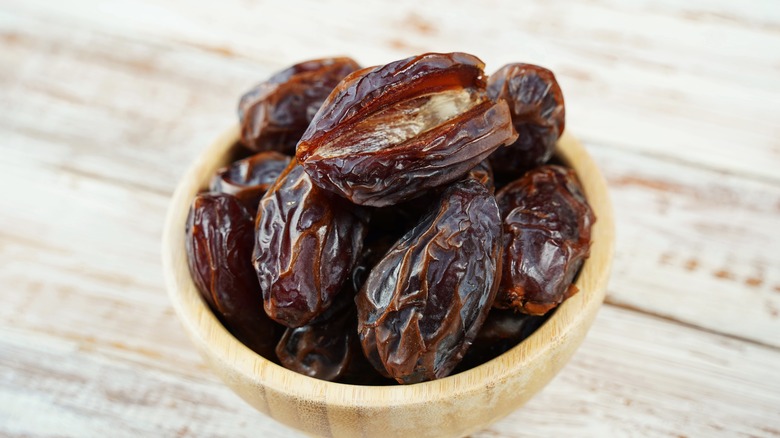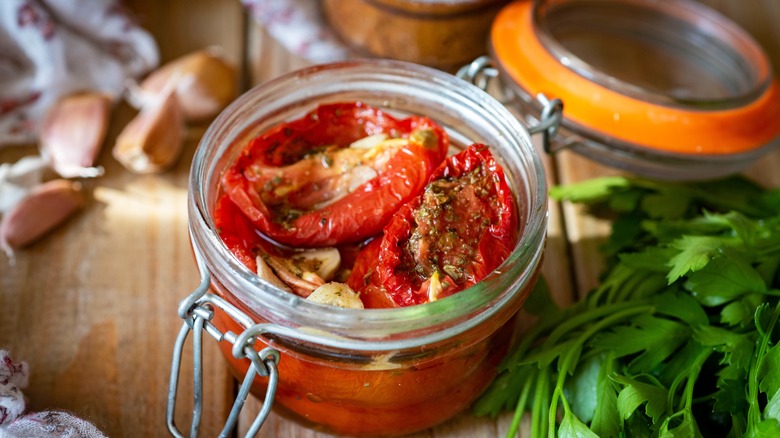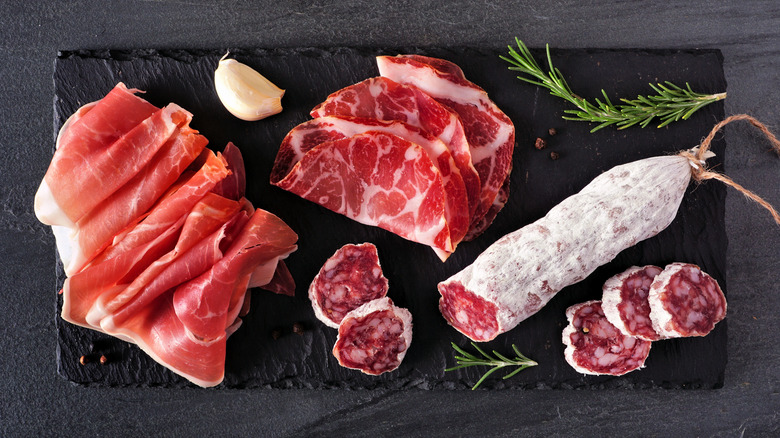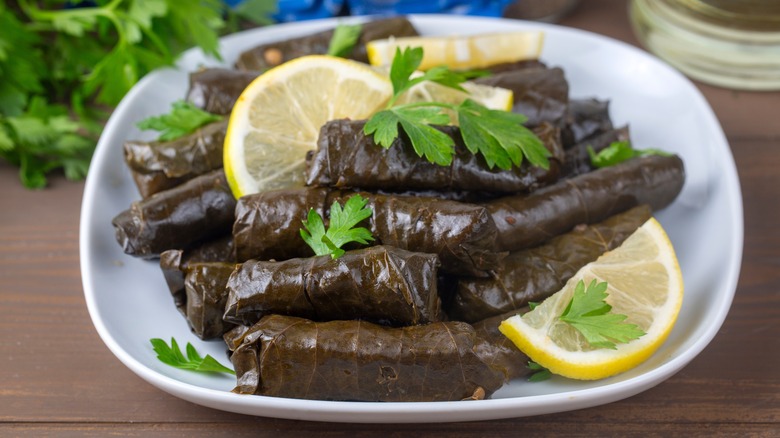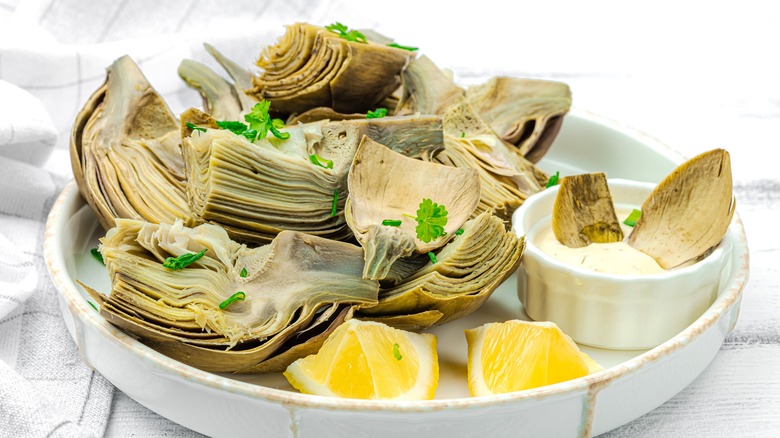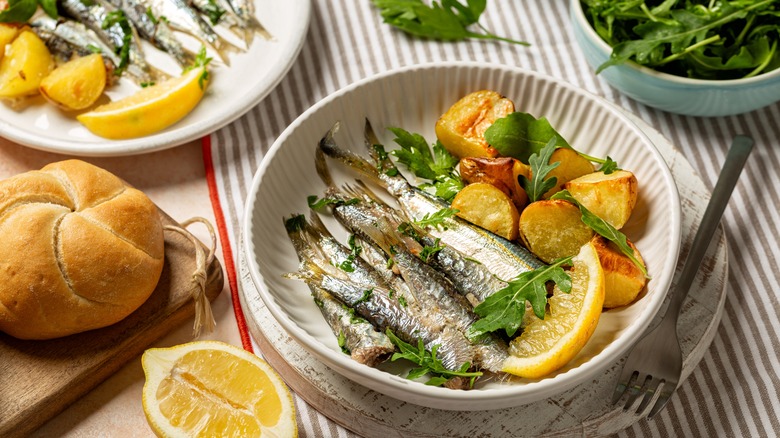15 Best Products To Buy At A Mediterranean Grocery Store
If you are lucky enough to live near a specialty Mediterranean grocery store, you will appreciate the feeling of looking around at the jars and bottles and feeling like a child in a candy shop. Even if you simply pop in for a jar of herbs, it can be hard to pull yourself away from the wonderful aromas that greet you as you walk in the door.
If you're looking to stock your pantry with Mediterranean ingredients, it can be hard to know where to begin. From staples such as olive oil to unique seasonings like za'atar, there are too many options to consider in one trip. Planning a strategy before you go is the best way to maximize your budget and pantry space, so let's take a look at the best products you should buy on your next trip to a Mediterranean store.
Extra-virgin olive oil
If there is one ingredient that should be at the top of any Mediterranean lover's shopping list, it has to be extra-virgin olive oil (EVOO). Used across the Med, it is integral to the cuisines of most countries in the region, though Italy, Greece, and Spain are the main producers.
You may have wondered what extra-virgin means when it comes to oil. To be classed as extra-virgin, olive oil must be unrefined, meaning it has not been heated or had anything added. The oil is extracted from the olives using cold-pressing, which historically meant that the oil was from the first cold press of the olives, and would naturally be of higher quality. Nowadays, all oil labeled virgin or extra-virgin is extracted at temperatures lower than 80.6 degrees Fahrenheit, meaning you don't need to worry about seeing cold-pressed on the label.
If you're going to splurge on a bottle of extra-virgin olive oil at your local Mediterranean store, you want to make sure that you use it appropriately. Since it is significantly more expensive than its "regular" counterpart, EVOO should be used for pouring, not for cooking. The beautiful flavor and viscosity will be lost in the cooking process so you can use a cheaper olive oil for that purpose. In addition to its magnificent taste, extra-virgin olive oil is packed with heart-healthy monounsaturated fats, making it a great addition to your everyday salads. The price tag may be a little hefty, but you won't regret buying a bottle of this golden elixir on your next shopping trip.
Dried herbs
Every home cook knows that herbs are your trusty sidekicks in the quest for flavor, elevating all sorts of dishes with their aromatic flavors. Fresh herbs are great when you can get them, but every well-stocked pantry should contain a variety of dried herbs as an alternative, especially if you love to cook Mediterranean cuisine.
In any good Mediterranean grocery store, you will find shelves filled with dried herbs such as oregano, thyme, rosemary, and sage, all of which can be used across various cuisines. Greek dishes are rich in oregano, whereas tarragon features in French cuisine, and sage in Italian. Having each of these common dried herbs on hand in your kitchen will allow you to capture the essence of your Mediterranean-inspired dishes without having to seek out fresh herbs each time. The shelf life of dried herbs is around 1-3 years, meaning you don't need to worry about them spoiling in between dishes, so permit yourself to buy a matching set of every herb under the sun — your taste buds will be eternally grateful.
Tahini
If you are a fan of hummus — and who isn't? — it is essential that you pick up a jar of tahini the next time you visit a Mediterranean grocery store. Essentially the sesame seed version of peanut butter, it has a deep, nutty flavor that can be added to numerous sweet and savory dishes. As long as you have some tahini on hand, homemade hummus can be made in minutes, and it is always going to taste much better than store-bought.
However, tahini has the potential for so much more than mere hummus. The Middle Eastern dip baba ghanoush features the toasted deliciousness that tahini brings. Tahini can elevate your usual morning avocado toast, or even be added to smoothies for a protein boost.
In addition to its distinctive flavor, tahini also has an impressive nutritional profile. It contains monounsaturated fats, known to reduce inflammation and potentially prevent serious disease, and is also rich in antioxidants. It serves as an excellent way to include these powerful compounds in your daily diet in the most delicious form possible.
Preserved lemons
If you haven't been using preserved lemons in your cooking, it's time to start. These tangy delicacies are used widely across the Mediterranean but feature heavily in Moroccan cuisine. They are often used in tagines and couscous dishes and are a great way to add the distinctive flavor of lemon to a meal without the overt tartness associated with the fresh fruit.
Preserved lemons are fresh lemons that have been soaked in brine for a month or more. The process of brining enhances the delicious lemon flavor of the citrus fruit and mellows the overall taste. Although often sold whole in jars, they are wonderful sliced into thin strips or diced, and scattered across dishes to offer a burst of surprise flavor.
While they will pair beautifully with Middle Eastern flavors, you can — and should — add preserved lemons to dishes from other cuisines. Next time you have a roast chicken salad, add some strips throughout the leaves to contrast with the rich flavor of the meat and the freshness of the salad. Grabbing a jar of these on your next trip to the Mediterranean store will brighten your meals for weeks to come.
Couscous
Couscous, a delicious alternative to rice and other grains, is underappreciated and should become a bigger feature of your weekly meal plans. Believe it or not, couscous is a type of pasta made from semolina flour, though we tend to treat it as a grain and serve it as an accompaniment or a salad. When cooked properly, it has a beautiful fluffy texture that can soak up sauces or provide a contrast to meat or fish.
While you can buy fresh couscous and cook it from scratch, most of us favor the convenience of the instant version, which can be ready in minutes. One trick to upgrade your instant couscous is to cook it in stock instead of hot water, imparting deep flavor into it as it cooks.
To serve couscous as a light salad, roast some Mediterranean veggies such as bell peppers, zucchini, and tomatoes and toss through the couscous with a drizzle of olive oil and fresh herbs. Alternatively, serve it alongside a stew or casserole and allow the pearls to soak up the rich sauce. However you choose to use it, having a few packs of couscous in your pantry will mean you have a quick and easy meal on hand for any midweek dinner.
Legumes
Legumes are a crucial element of the Mediterranean diet, from chickpeas to lentils and so many beans in between. These nutritional superstars are full of flavor and can accompany many dishes, adding a filling element that is both healthy and tasty. All legumes are packed with protein, making them the ideal option if you are following a plant-based diet or trying to reduce your meat consumption. They are also high in fiber and can reduce the chance of developing serious diseases such as diabetes or heart disease.
Chickpeas, of course, are the star of hummus, and you can easily whip some up using the tahini that you also bought at the Mediterranean store. They also work great in a salad alongside fresh elements like spinach, avocado, and olives.
Lentils are versatile and make a fantastic addition to lots of Mediterranean dishes. From soups to salads, their earthy flavor and soft texture can complement other ingredients to create a satisfying meal. Other legumes, such as fava beans or black beans, can also add a filling option to salads. Or serve them as a side dish in their own right, seasoned with fresh herbs and a squeeze of lemon. Your local Mediterranean store should sell a variety of canned legumes, making it easy to add a burst of nutrition and satiety to a meal whenever you wish.
Pomegranate molasses
One ingredient from the Mediterranean store that you may not have tried before is pomegranate molasses, but once you have added it to your shopping list, it will be a mainstay in your pantry. Often used in Middle Eastern cuisine, it is a rich, thick syrup with a wonderfully sweet but tart flavor, and makes an excellent dressing for couscous, salads, and appetizers.
The term molasses refers to sugar that has been reduced down to a syrup, in this case from pomegranate juice. The juice is simmered gently until it turns into a viscous, dark pink syrup. The best molasses will not have any added sugars or sweeteners, allowing the glorious pomegranate flavor to shine through.
If you've never used this Mediterranean ingredient before, it's time to start adding it to just about everything! Include it in your next marinade for meat or fish, drizzle it over veggies before roasting in the oven, or even add it to desserts for a tangy (and healthier) alternative to your usual syrup. Since pomegranates are known for their high antioxidant content, you can rest assured that your new go-to drizzle is benefiting your health as well as your palate.
Olives
When you think of Mediterranean snacks, one of the first foods that likely jumps to mind is olives. Savory and salty, olives are a satisfying mouthful often served with drinks but can just as happily lift the flavor of Mediterranean dishes.
Broadly speaking, olives can be split into a few categories based on their color, with green, brown, and black being the most common. The color varies depending on their ripeness when they are picked, starting as green and ripening through to black. For this reason, green olives are considered more bitter than brown or black, which have had more chance on the vine to mature.
In your Mediterranean store, you should be able to choose from a wide variety of olives including kalamata, nocellara, and ones stuffed with pimentos, anchovies, or chilies. Whether you want to toss them into a pasta puttanesca or serve them as part of an antipasto platter, as a fan of Mediterranean food, you can never have too many jars of olives in your pantry.
Za'atar
For those unfamiliar with za'atar, it is a delicious blend of herbs and spices used across the Mediterranean. Consisting of herbs such as thyme and oregano, toasted sesame seeds, ground sumac, and salt, it's the ultimate savory seasoning. If you've never used it before, you are missing out.
The versatility of za'atar means it can be used to elevate many dishes, especially those that already have Mediterranean flavors. Add it to your vinaigrette before drizzling over a fresh salad, or rub it into chicken skin before roasting. Wherever you would usually use salt, you can substitute za'atar to create a flavor explosion.
When shopping for a jar of za'atar, check the ingredients to ensure it is of high quality, without any fillers. While every blend will be slightly different, a bright green color throughout is a good sign that the herbs will still have plenty of flavor. You might want to buy an extra jar just in case — once you've started sprinkling this stuff, it's hard to stop!
Dates
If you have a sweet tooth, dates are a brilliant way to satisfy any craving without reaching for a candy bar. They are stone fruits (like plums or apricots), and the vast majority of dates sold in the U.S. are dried. While they can be put to great use in a variety of desserts, in Mediterranean cooking you will often find them adding a sweet touch to a savory dish.
Despite their extremely sweet flavor, dates are considered a low-glycemic fruit, with a GI score of around 42, meaning they are considered safe to eat as a healthy snack, even for diabetics. This means they can be used to replace refined sugar in your homemade desserts and provide sweet treats that everyone can enjoy.
In savory food, they go brilliantly with cheese or can be chopped and added to a fresh salad for a surprise burst of sweetness. For a simple and mouthwatering appetizer, stuff them with a creamy cheese such as goat cheese, then wrap them with a sliver of prosciutto. The contrast of salty, sweet, and creamy will create paradise on your palate, and you may find yourself scarfing the whole plate before you've even served it.
Sun-dried tomatoes
One of the quintessential vegetables (well, technically fruits) of the Mediterranean is the vibrant tomato. If ever there was anything more fabulous than a fresh, juicy tomato, it could only be the sun-dried version. Gently dried in the sun (hence the name) until the majority of the water is gone, the tomato flavor is then concentrated into a marvelous, super-umami morsel.
Originally discovered by the Italians, sun-dried tomatoes are now used across the Mediterranean to add an explosion of tomatoey goodness to salads, couscous, or pasta sauce. You can buy them in different forms, with sun-blushed being the least dried, and usually soaked in olive oil, while dry-packed tomatoes are shriveled and have virtually no moisture left. They can be easily hydrated by soaking in water for a few minutes if you want to return a bit of plumpness to them. Don't discard either the water or oil that your sun-dried tomatoes have been in — there will be plenty of flavor in it that you can add to sauces or stocks, or use as a substitute for your usual salad oil.
Cured meats
When you think of a Mediterranean appetizer, it's likely that cured meats feature in some form. From Italian prosciutto to Spanish chorizo, there is a wide range of salty options to choose from, and any Mediterranean store should stock a large selection.
Cured meat is meat that, rather than being cooked, is cured using salt and spices, which removes the majority of harmful microbes. The length of time this takes can range from a few weeks with smaller cuts, to many months for a large piece of meat. Different compounds can be added to some meats which affect the color and flavor of the meat, but Parma Ham, one of the most famous cured meats, is allowed nothing but pork and salt as ingredients.
There are so many ways to use cured meats, from wrapping them around fruits and vegetables to frying them and enjoying them as a crispy topping on pasta. Or, if you just want to enjoy the beautiful flavor at its finest, pair them with a few other ingredients on this list and serve a delectable antipasti board.
Dolmas
Dolmas (also called dolmades) are tiny little parcels of flavor often found on mezze boards, the Greek version of an antipasti platter. From the Turkish word for 'stuffed', these little morsels are usually formed from vine leaves wrapped around rice, meat, and vegetables. They are commonly eaten in Greece, Turkey, and the Middle East, and if you haven't tried them, you should pick some up from your local store.
To make a classic mezze board, serve the dolmas with homemade hummus, baba ghanoush, pita bread, and olives. You can also add in your favorite Mediterranean ingredients, from cured meats to creamy cheeses, and some grilled vegetables to add some fresh flavor. Whether you choose lamb dolmas or a vegetarian version, they will complement the rest of the ingredients on the board and bring a taste of Greece to your table.
Artichokes
Artichokes are an underused ingredient, partly due to the difficulty of preparing them from fresh. But you should be able to buy artichoke hearts in cans or jars from a Mediterranean grocery store, meaning there is no excuse not to add these wonderful vegetables to your weekly meals.
Artichokes are a classic ingredient in Italian cuisine and feature in many dishes. They make an excellent pizza topping, lending a sharp but sweet element that complements the cheese and tomato nicely. They also make an exquisite side dish when roasted or fried with garlic and a good squeeze of fresh lemon juice. Alternatively, add halved artichoke hearts to a fresh green salad, where the layers will soak up the wonderful flavors of the vinaigrette.
For the ultimate veggie-based dip, blending artichokes with spinach and cream cheese hits all the flavor and texture notes, and you can even make it in your slow cooker. With so many terrific uses for artichokes, it will be worthwhile purchasing a few jars on your next trip to the store.
Sardines or anchovies
Since we are advised to eat two portions of oily fish each week, stocking up your pantry with some sardines or anchovies is a great way to get your omega-3 fill. In the U.S., both of these fish tend to get overlooked for bigger seafood such as salmon and tuna, but in the Mediterranean, these nutritional superstars are a big hit.
Sardines are the more substantial of the two fish and feature regularly in salads or as appetizers. They have a strong flavor and work well with a squeeze of lemon juice and a twist of salt. Anchovies are much smaller and are often added to dishes for a boost of salty, umami taste. Many Italian sauces use anchovies to create a depth of flavor, and it may be worth throwing a few into your next marinara sauce — they dissolve to virtually nothing and there is no noticeable fishy taste. With their long shelf life, it is worth having a can of both fish sitting on the shelf in your kitchen.
